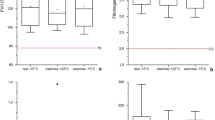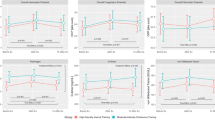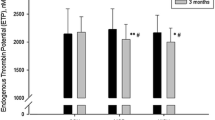Abstract
The influence of different exercise intensities on haemostasis in healthy, untrained subjects has not been intensively studied. We investigated untrained subjects for alterations in coagulation and fibrinolysis induced by two exercise intensities, precisely controlled by individual anaerobic threshold (IAT). Twenty-five healthy, untrained non-smokers (age 25 ± 3 years; relative VO2 peak 43.1 ± 5.2 ml/kg/min) underwent exercise tests at 80% (moderate) and 100% (strenuous) of IAT for 60 min. Blood samples were taken after 30 min rest and immediately after exercise. The present results reveal that an exercise intensity at 100% IAT induces a more pronounced coagulation activity than exercises at 80% IAT. 100% IAT led to a significant higher increase in FVIII (80% IAT 85 ± 33 to 114 ± 30% vs. 100% IAT 81 ± 20 to 132 ± 29%) and TAT (80% IAT 2.5 ± 1.4 to 2.9 ± 1.0 μg/l vs. 100% IAT 2.6 ± 1.0 to 5.4 ± 4.2 μg/l). Furthermore, both exercises affected fibrinolysis, but it was significantly higher at 100% IAT (tPA activity; 80% IAT 0.44 ± 0.17 to 4.65 ± 2.67 U/ml vs. 100% IAT 0.43 ± 0.19 to 6.47 ± 3.97 U/ml). The data show that fibrinolytic activity is significantly elevated already after moderate exercise (80% IAT). After strenuous exercise (100% IAT), coagulation is more sharply enhanced together with a higher increase of fibrinolysis in comparison with 80% IAT. However, haemostasis seems to be in balance after moderate as well as after strenuous exercise intensity in healthy, untrained participants. Based on these data, exercise-induced changes of both haemostatic systems should also be tested in patients with cardiovascular diseases in order to be in a position to give recommendations for endurance training modalities in rehabilitation training.
Similar content being viewed by others
Abbreviations
- ETP:
-
Endogenous thrombin potential
- Ex:
-
Extrinsic
- F1 + 2:
-
Prothrombin fragment 1 + 2
- HR:
-
Heart rate
- IAT:
-
Individual anaerobic threshold
- In:
-
Intrinsic
- PAP:
-
Plasmin–α2–antiplasmin complex
- PLG:
-
Plasminogen
- PT:
-
Prothrombin time
- TAT:
-
Thrombin–antithrombin complex
- TP:
-
Thrombin potential
- tPA:
-
Tissue-type plasminogen activator
- TTP:
-
Total thrombin potential
- uPA:
-
Urokinase plasminogen activator
- rel. VO2 :
-
Relative oxygen uptake
References
Acil T, Atalar E, Sahiner L, Kaya B, Haznedaroglu IC, Tokgozoglu L, Ovunc K, Aytemir K, Ozer N, Oto A, Ozmen F, Nazli N, Kes S, Aksoyek S (2007) Effects of acute exercise on fibrinolysis and coagulation in patients with coronary artery disease. Int Heart J 48:277–285
Andrew M, Carter C, O’Brodovich H, Heigenhauser G (1986) Increases in factor VIII complex and fibrinolytic activity are dependent on exercise intensity. J Appl Physiol 60:1917–1922
Cadroy Y, Pillard F, Sakariassen KS, Thalamas C, Boneu B, Riviere D (2002) Strenuous but not moderate exercise increases the thrombotic tendency in healthy sedentary male volunteers. J Appl Physiol 93:829–833
Chandler WL, Levy WC, Stratton JR (1995) The circulatory regulation of TPA and UPA secretion, clearance, and inhibition during exercise and during the infusion of isoproterenol and phenylephrine. Circulation 92:2984–2994
Crowder MJ, Hand DJ (1990) Analysis of repeated measures. Chapman & Hall, London
Dill DB, Costill DL (1974) Calculation of percentage changes in volumes of blood, plasma, and red cells in dehydration. J Appl Physiol 37:247–248
Drygas WK (1988) Changes in blood platelet function, coagulation, and fibrinolytic activity in response to moderate, exhaustive, and prolonged exercise. Int J Sports Med 9:67–72
Dufaux B, Order U, Hollmann W (1984) Can physical exercise induce an effective fibrinolysis? Thromb Res 36:37–43
El-Sayed MS (1996) Effects of exercise on blood coagulation, fibrinolysis and platelet aggregation. Sports Med 22:282–298
El-Sayed MS, El-Sayed Ali Z, Ahmadizad S (2004) Exercise and training effects on blood haemostasis in health and disease: an update. Sports Med 34:181–200
Faude O, Kindermann W, Meyer T (2009) Lactate threshold concepts: how valid are they? Sports Med 39:469–490
Faul F, Erdfelder E, Lang AG, Buchner A (2007) G*Power 3: a flexible statistical power analysis program for the social, behavioral, and biomedical sciences. Behav Res Methods 39:175–191
Gunga HC, Kirsch K, Beneke R, Boning D, Hopfenmuller W, Leithauser R, Hutler M, Rocker L (2002) Markers of coagulation, fibrinolysis and angiogenesis after strenuous short-term exercise (Wingate-test) in male subjects of varying fitness levels. Int J Sports Med 23:495–499
Handa K, Terao Y, Mori T, Tanaka H, Kiyonaga A, Matsunaga A, Sasaki J, Shindo M, Arakawa K (1992) Different coagulability and fibrinolytic activity during exercise depending on exercise intensities. Thromb Res 66:613–616
Hegde SS, Goldfarb AH, Hegde S (2001) Clotting and fibrinolytic activity change during the 1 h after a submaximal run. Med Sci Sports Exerc 33:887–892
Hemker HC, Beguin S (1995) Thrombin generation in plasma: its assessment via the endogenous thrombin potential. Thromb Haemost 74:134–138
Hemker HC, Wielders S, Kessels H, Beguin S (1993) Continuous registration of thrombin generation in plasma, its use for the determination of the thrombin potential. Thromb Haemost 70:617–624
Hilberg T, Prasa D, Sturzebecher J, Glaser D, Gabriel HH (2002) Thrombin potential and thrombin generation after exhaustive exercise. Int J Sports Med 23:500–504
Hilberg T, Eichler E, Glaser D, Prasa D, Sturzebecher J, Gabriel HH (2003a) Blood coagulation and fibrinolysis before and after exhaustive exercise in patients with IDDM. Thromb Haemost 90:1065–1073
Hilberg T, Glaser D, Reckhart C, Prasa D, Sturzebecher J, Gabriel HH (2003b) Blood coagulation and fibrinolysis after long-duration treadmill exercise controlled by individual anaerobic threshold. Eur J Appl Physiol 90:639–642
Hilberg T, Prasa D, Sturzebecher J, Glaser D, Schneider K, Gabriel HH (2003c) Blood coagulation and fibrinolysis after extreme short-term exercise. Thromb Res 109:271–277
Hilberg T, Menzel K, Glaser D, Zimmermann S, Gabriel HH (2008) Exercise intensity: platelet function and platelet-leukocyte conjugate formation in untrained subjects. Thromb Res 122(1):77–84
Ikarugi H, Taka T, Nakajima S, Noguchi T, Watanabe S, Sasaki Y, Haga S, Ueda T, Seki J, Yamamoto J (1999) Norepinephrine, but not epinephrine, enhances platelet reactivity and coagulation after exercise in humans. J Appl Physiol 86:133–138
Ikarugi H, Shibata M, Shibata S, Ishii H, Taka T, Yamamoto J (2003) High intensity exercise enhances platelet reactivity to shear stress and coagulation during and after exercise. Pathophysiol Haemost Thromb 33:127–133
Kawano TA, Aoki N, Homori M, Kawano K, Maki A, Kimura M, Yanagisawa A, Ohsaki T, Takahashi R, Shiohara T, Ishikawa K, Yoshino H (2000) Mental stress and physical exercise increase platelet-dependent thrombin generation. Heart Vessels 15:280–288
Kindermann W (2004) Anaerobe Schwelle. Dtsch Z Sportmed 55:161–162
Meyer T, Gabriel HH, Kindermann W (1999) Is determination of exercise intensities as percentages of VO2max or HRmax adequate? Med Sci Sports Exerc 31:1342–1345
Papadaki M, Ruef J, Nguyen KT, Li F, Patterson C, Eskin SG, McIntire LV, Runge MS (1998) Differential regulation of protease activated receptor-1 and tissue plasminogen activator expression by shear stress in vascular smooth muscle cells. Circ Res 83:1027–1034
Parmer RJ, Mahata M, Mahata S, Sebald MT, O’Connor DT, Miles LA (1997) Tissue plasminogen activator (t-PA) is targeted to the regulated secretory pathway catecholamine storage vesicles as a reservoir for the rapid release of t-PA. J Biol Chem 272:1976–1982
Prasa D, Svendsen L, Sturzebecher J (1997a) Inhibition of thrombin generation in plasma by inhibitors of factor Xa. Thromb Haemost 78:1215–1220
Prasa D, Svendsen L, Sturzebecher J (1997b) The ability of thrombin inhibitors to reduce the thrombin activity generated in plasma on extrinsic and intrinsic activation. Thromb Haemost 77:498–503
Stegmann H, Kindermann W, Schnabel A (1981) Lactate kinetics and individual anaerobic threshold. Int J Sports Med 2:160–165
Szymanski LM, Pate RR (1994) Effects of exercise intensity, duration, and time of day on fibrinolytic activity in physically active men. Med Sci Sports Exerc 26:1102–1108
Taniguchi N, Furui H, Yamauchi K, Sotobata I (1984) Effects of treadmill exercise on platelet functions and blood coagulating activities in healthy men. Jpn Heart J 25:167–180
Urhausen A, Coen B, Weiler B, Kindermann W (1993) Individual anaerobic threshold and maximum lactate steady state. Int J Sports Med 14:134–139
van den Burg PJ, Hospers JE, van Vliet M, Mosterd WL, Bouma BN, Huisveld IA (1995) Changes in haemostatic factors and activation products after exercise in healthy subjects with different ages. Thromb Haemost 74:1457–1464
von Kanel R, Dimsdale JE (2000) Effects of sympathetic activation by adrenergic infusions on hemostasis in vivo. Eur J Haematol 65:357–369
Weiss C, Seitel G, Bartsch P (1998a) Coagulation and fibrinolysis after moderate and very heavy exercise in healthy male subjects. Med Sci Sports Exerc 30:246–251
Weiss C, Velich T, Niebauer J, Hauer K, Kalberer B, Kubler W, Bartsch P (1998b) Activation of coagulation and fibrinolysis after rehabilitative exercise in patients with coronary artery disease. Am J Cardiol 81:672–677
Weiss C, Welsch B, Albert M, Friedmann B, Strobel G, Jost J, Nawroth P, Bartsch P (1998c) Coagulation and thrombomodulin in response to exercise of different type and duration. Med Sci Sports Exerc 30:1205–1210
Acknowledgments
The authors would like to thank Prof. Dr. H. Gabriel, Mrs. B. Dorschner and Mrs. B. Tauch from the Department of Sports Medicine at the Friedrich-Schiller-University Jena for their kind support; Mrs. I. Schellenberg for the excellent measurements of TTP and ETP; Dr. W. Ackermann for the assessment of several coagulation factor activities; Mrs. Wagner, Technoclone GmbH, Vienna, Austria; Mr. T. Noll, Dade Behring, Marburg, Germany for their support with ELISA kits.
Conflict of interest
The authors declare that they have no conflict of interest.
Author information
Authors and Affiliations
Corresponding author
Additional information
Communicated by Susan Ward.
Dedicated to Prof. Dr. Jörg Stürzebecher (deceased).
Rights and permissions
About this article
Cite this article
Menzel, K., Hilberg, T. Blood coagulation and fibrinolysis in healthy, untrained subjects: effects of different exercise intensities controlled by individual anaerobic threshold. Eur J Appl Physiol 111, 253–260 (2011). https://doi.org/10.1007/s00421-010-1640-2
Accepted:
Published:
Issue Date:
DOI: https://doi.org/10.1007/s00421-010-1640-2




